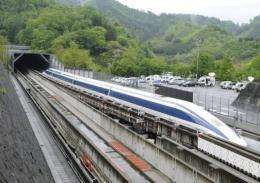Japan to launch 'Hayabusa' bullet train

Japan's latest bullet train, the thin-nosed "Hayabusa" or Falcon, will make its 300 kilometre per hour (186 mph) debut Saturday, boasting a luxury carriage modelled on airline business class.
Japan has built up a network of cutting-edge Shinkansen train lines since the 1960s that criss-cross the island nation and now hopes to sell the infrastructure technology abroad, including to the United States.
The latest ultra-fast tech-marvel will make three trips a day from Tokyo to the city of Aomori, in a scenic rural backwater on the northern tip of the main Honshu island that has until now been off Japan's bullet train map.
The green-and-silver E5 series Hayabusa will travel at up to 300 kmh to make the 675 kilometre trip in three hours and 10 minutes. From next year, it will push its top speed to 320 kmh to become Japan's fastest train.
Passengers will glide quietly through the straights and tunnels that cut through Japan's mountainous countryside, says operator East Japan Railway Co, which has heavily promoted the launch of the new service.
Those willing to pay 26,360 yen ($320) for a one-way trip can enjoy the comfort of a 'GranClass' car, where a cabin attendant will serve them as they enjoy deeply reclining leather seats and thick woollen carpets.
To promote the service, the train company has also heavily advertised Aomori as a tourist destination, praising its landscape, seafood and winter snow.
Japan's ultra-fast, frequent and punctual bullet trains have made them the preferred choice for many travellers, rather than flying or road travel, ever since the first Shinkansen was launched in time for the 1964 Tokyo Olympics.
But as Japan, and its railway companies, struggle with a fast-greying and shrinking population and falling domestic demand, the government and industry are aggressively seeking to promote the bullet trains abroad.
Japan has in the past sold Shinkansen technology to Taiwan and hopes to capture other overseas markets, such as Brazil and Vietnam, but faces stiff competition from train manufacturers in China, France and Germany.
The biggest prize is a future high-speed US rail network that President Barack Obama has promoted, to be backed by 13 billion dollars in public funding.
California's then-governor Arnold Schwarzenegger was treated to an early test ride on the Hayabusa when he visited Japan in September.
Japan says its trains boast a strong safety record: despite running in an earthquake-prone country, no passenger has ever died due to a Shinkansen derailment or collision -- although people have committed suicide by jumping in front of the trains.
Japan has also been developing a magnetic levitation or maglev train that, its operator says, reached a world record speed of 581 kilometres per hour in 2003 on a test track near Mount Fuji in Tsuru, west of Tokyo.
The plan is to launch maglev services between Tokyo and the central city of Nagoya by 2027. By 2045 they are expected to link Tokyo with the main western city of Osaka in just one hour and seven minutes, compared with the current two hours 25.
(c) 2011 AFP



















